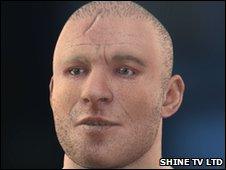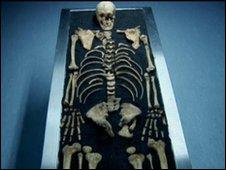Stirling Castle knight revealed as English nobleman
- Published

The skeleton of the knight was discovered during refurbishment work
A skeleton discovered at Stirling Castle may have been an English knight who died in the 14th Century.
Sir John de Stricheley died in 1341, when the English held the castle.
An investigation into the skeleton by forensic anthropologist Professor Sue Black and her team from the University of Dundee was featured on BBC Two's History Cold Case series on Thursday.
The battle-scared knight probably died from an arrow wound inflicted by the Scots.
The skeleton was one of 10 excavated from the site of a lost royal chapel at the castle during refurbishment works in 1997. The skeleton of a woman whose head had apparently been smashed with a mace was found near the knight.
Documents uncovered by the team showed that Sir John, a Buckinghamshire lord, was a senior member of the garrison. He died on 10 October 1341 and his family line has since died out.
Prof Black said piecing together the potential identity of the knight was "absolutely unexpected".
"When you start with something that was less than optimal, the chances of getting it back to even a possible name is much better that we could even have expected."

Research results will feature in a permanent exhibition at Stirling Castle
However the identity of the woman buried next to him will probably never be known as women were not deemed important enough for their deaths to be recorded.
A reconstruction revealed what the knight, who was a "very strong and fit nobleman, with the physique of a professional rugby player", may have looked like.
Forensic examinations of his bones showed the 5ft 7in (1.7m) man probably grew up in southern England, was an experienced soldier, had survived serious injuries in previous battles and probably died in his mid-20s.
Richard Strachan, senior archaeologist with Historic Scotland, said the facial reconstruction gave a "powerful impression" of what the knight's appearance would have been.
The facial reconstruction and other research results will feature in a permanent exhibition due to open at Stirling Castle next spring.
Historic Scotland, which cares for the castle, has announced it is commissioning further research to find out more about the 10 skeletons, which include two infants.
They date from the 13th to 15th Centuries and were found during preparatory work for a £12m refurbishment of the castle's Renaissance royal palace.